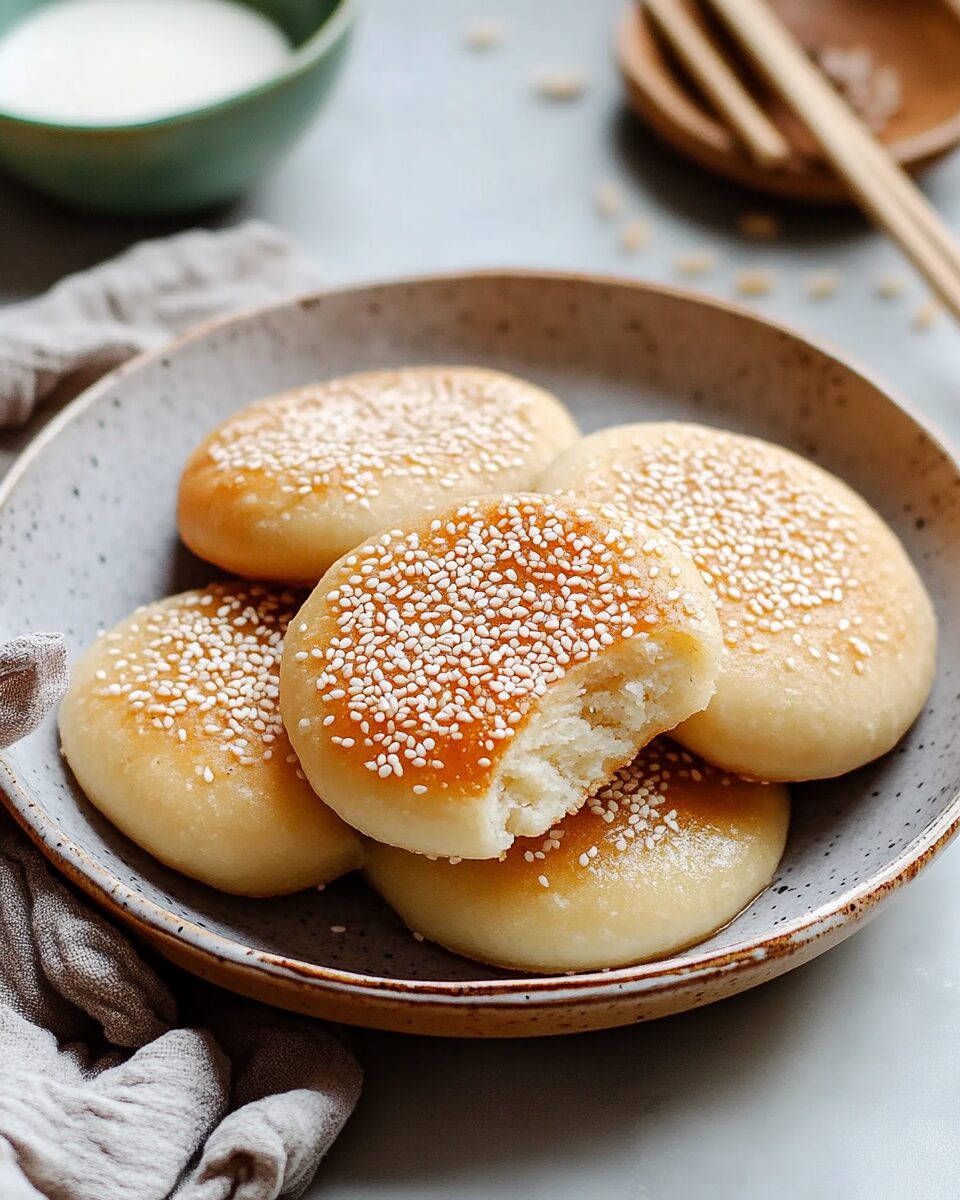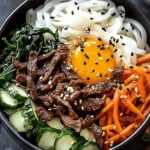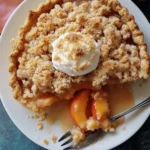The magic of Vietnamese street food comes alive in these tender and golden Bánh Tiêu, also known as Vietnamese Hollow Sesame Donuts. These pillowy, deep-fried treats puff up into a hollow center and are finished with a nutty sesame seed coating. Lightly sweet, beautifully crisp, and endlessly versatile, they’re just as delightful on their own as they are filled with chocolate, nut butter, or savory fillings.
Perfectly simple yet incredibly satisfying, Bánh Tiêu is a nostalgic snack many grew up enjoying from roadside vendors. Whether you’re craving a cozy afternoon treat or planning something unique for brunch, these donuts deliver on both texture and taste. They’re a must-try for any home baker looking to explore the flavors of Vietnam with a modern plant-based twist.
Full Recipe:
-
2 cups (280g) all-purpose flour
-
1/4 cup (50g) sugar
-
3/4 tsp instant yeast
-
3/4 tsp baking powder
-
1/4 tsp salt
-
10 tbsp (150ml) unsweetened almond milk (or any plant-based milk)
-
1/2 tsp vanilla extract (optional)
-
1/4 cup (35g) raw white sesame seeds
-
1½ cups (355ml) oil for frying
Directions:
-
In a mixing bowl, whisk together flour, sugar, instant yeast, baking powder, and salt.
-
Add almond milk and vanilla extract to the bowl. Stir with a spoon until a dough forms.
-
Knead the dough by hand for 5–7 minutes until smooth and slightly sticky, like pizza dough.
-
Cover the bowl with plastic wrap and let the dough rise at room temperature for 1.5 hours or until doubled in size.
-
Once risen, punch the dough down and divide it into 6 equal pieces.
-
Roll each dough ball into raw sesame seeds, pressing gently so the seeds adhere.
-
Flatten each ball into a 3–4mm thick disc using a rolling pin. Let them rest for 10 minutes.
-
Heat 1½ cups of oil in a deep saucepan over medium heat. Test with a wooden chopstick—if bubbles form, it’s ready.
-
Carefully place one disc in the hot oil and flip every 5–7 seconds with chopsticks or wooden spatulas. The disc should puff up and turn golden.
-
Remove with a slotted spoon and drain on paper towels. Repeat with the remaining discs.
-
Let the donuts cool for 5 minutes before serving.
Prep Time: 15 minutes | Cooking Time: 10 minutes | Total Time: 1 hour 55 minutes
Kcal: 342 kcal | Servings: 6 donuts
A Cultural Delight: The Story Behind Bánh Tiêu
Bánh Tiêu, a traditional Vietnamese street food staple, is a light and airy donut with a hollow interior and a nutty sesame-coated crust. Often referred to as Vietnamese hollow donuts or even Vietnamese beignets, these simple yet delightful pastries hold a special place in the hearts of many across the country. You can find them sizzling in large pots of oil on the side of the road, sold by street vendors who make them fresh on demand. Their aroma is unmistakable: a fusion of fried dough and toasted sesame seeds that immediately grabs your attention and stirs nostalgic cravings.
While Western donuts tend to be rich and sugar-laden with frosting or cream fillings, Bánh Tiêu takes a more minimalist approach. They are only mildly sweet and can be enjoyed on their own or stuffed with sweet or savory fillings, making them an incredibly versatile treat. The texture is key—when made properly, they puff into golden brown discs that are light, slightly chewy, and hollow in the center.
Origins and Cultural Significance
The origins of Bánh Tiêu are somewhat murky, but like many dishes in Vietnam, its influence is believed to come from neighboring cultures, particularly Chinese fried breads like youtiao. Over the years, Vietnamese cooks adapted and refined the idea into something uniquely their own. Rather than being served alongside porridge like youtiao, Bánh Tiêu is often eaten as a snack or dessert, either on its own or filled with sweet pastes and sometimes even ice cream.
In Vietnam, Bánh Tiêu is more than just food—it is tied to memory, family, and everyday life. It’s common to see elderly vendors selling these donuts during early mornings and late afternoons when people are looking for a quick snack. Children often enjoy them warm after school, and adults accompany them with a cup of hot tea or strong Vietnamese coffee. It’s a dish that crosses generations, always evoking a sense of home and familiarity.
Texture and Flavor Profile
One of the defining characteristics of Bánh Tiêu is its hollow interior, which gives it an airy and lightweight quality. This puffing effect occurs when the dough is flattened and then quickly fried in hot oil, creating a steam pocket that expands rapidly. The outside becomes crispy and golden while the inside remains soft, almost like a pillow of air.
The addition of sesame seeds on the exterior adds not only visual appeal but also a toasty, nutty flavor that perfectly complements the light sweetness of the dough. Bánh Tiêu is not overly sugary, which is why it pairs so well with both sweet and savory fillings. Think chocolate spread, coconut jam, or even tofu with pickled vegetables. The dough itself is mildly flavored, which makes it the perfect canvas for experimentation.
Modern Adaptations and Variations
Though the traditional Bánh Tiêu recipe is quite simple and rooted in old-fashioned techniques, modern home cooks and chefs have found creative ways to reinvent the classic. Some variations now include fillings injected before or after frying, using ingredients like pandan custard, sweet mung bean paste, or chocolate ganache. Others explore savory territory, using the hollow space to hold stir-fried vegetables, tofu, or mock meats, transforming the sweet pastry into a handheld meal.
Additionally, the recipe has traveled outside Vietnam and is being adapted for different dietary needs. Many plant-based and vegan food bloggers have taken an interest in Bánh Tiêu because of how easily it can be made without eggs or dairy. Using plant-based milk and a few pantry staples, vegans can enjoy the same chewy, crispy experience with no compromise in flavor or texture.
Some bakers are even experimenting with air-frying or oven-baking methods. While purists would argue that deep frying is essential to achieving the signature puff and golden crust, healthier versions still attempt to recreate the same magic with less oil.
Tips for the Perfect Bánh Tiêu
While we’re not diving into step-by-step instructions, understanding a few tips and tricks can help readers appreciate the skill involved in crafting the perfect Bánh Tiêu. One of the most crucial elements is dough consistency. The dough needs to be soft, slightly sticky, and elastic. If it’s too dry, it won’t puff properly, and the sesame seeds won’t adhere well. If it’s too wet, the donuts may absorb too much oil and turn out greasy.
Another key factor is resting time. After shaping and flattening the dough, allowing it to rest before frying helps develop the internal structure needed for the puffing process. This rest also relaxes the gluten in the flour, which makes the texture more tender and less dense.
Temperature control during frying is essential. The oil needs to be hot enough (around 350°F or 175°C) to trigger rapid puffing but not so hot that the exterior browns before the interior is cooked. A common test is to insert a wooden chopstick into the oil—if bubbles form around it, the oil is ready. Flipping the dough repeatedly ensures even puffing and color.
Pairings and Serving Ideas
Traditionally, Bánh Tiêu is served plain or with a simple sprinkle of sugar. However, there are many exciting ways to elevate the dish. For a sweet version, consider pairing it with vegan condensed milk, fruit preserves, or a scoop of ice cream. For a savory twist, stuff it like a pita with sautéed mushrooms, crispy tofu, and fresh herbs for a Southeast Asian-style sandwich.
Another modern take involves using Bánh Tiêu as a vehicle for fusion cuisine. It can act as a base for banh mi-inspired fillings or even Middle Eastern spreads like hummus and baba ghanoush. Because of its neutral flavor profile, it works surprisingly well with a wide range of global flavors.
When serving guests, plating can enhance the experience. Stack the donuts and dust them with powdered sugar or sesame powder. Serve with dipping sauces in small bowls, from chocolate ganache to spicy peanut sauce. Presentation, as with any dish, adds to the enjoyment and elevates the dining experience.
Storage and Reheating Tips
Bánh Tiêu is best enjoyed fresh, ideally within minutes of frying when the exterior is still crisp and the interior tender. However, they can be stored in an airtight container at room temperature for up to two days. While they’ll lose some of their crunch, the texture can be revived by reheating in an oven at 350°F for about 8–10 minutes.
Freezing is also an option if you want to make them in advance. Simply wrap the cooled donuts in plastic wrap, then in foil, and store them in the freezer for up to two months. To enjoy, allow them to thaw at room temperature and reheat in the oven for a few minutes.
Advertisement
Conclusion
Bánh Tiêu is much more than just a fried snack—it is a symbol of Vietnamese culinary ingenuity, a reminder of warm street corners, bustling food carts, and home kitchens filled with laughter and frying oil. Its simplicity is what makes it extraordinary. With just a handful of ingredients and some basic techniques, you can create a pastry that is light yet satisfying, nostalgic yet versatile, and humble yet deeply rewarding.
In a world that often chases complex flavors and extravagant presentations, Bánh Tiêu stands as a beautiful example of how joy can come from the simplest things. Whether you’re enjoying it fresh from a street vendor in Ho Chi Minh City or trying your hand at it in your kitchen thousands of miles away, one bite will transport you to the heart of Vietnam.
This beloved donut is not just a recipe—it’s a story, a memory, and a moment of delicious simplicity waiting to be shared.






